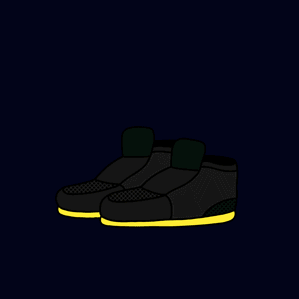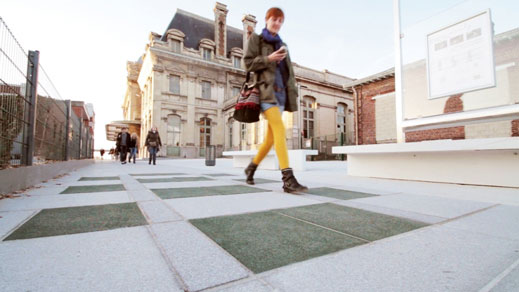The Quest to Make Your Shoe a Power Source
Children have been harnessing energy from their steps ever since 1992, when L.A. Gear introduced sneakers that light up. For most adults, however, the ambient energy created by the simple act of walking is forever lost. Considering that the average person takes around 216 million steps in a lifetime, it’s a significant waste.

Inventor Laurence Kemball-Cook hopes to harness the lost energy at two points of contact: the shoe and the floor. In 2009, Kemball-Cook founded Pavegen, a company whose floor tiles can capture the power of footsteps. The technology uses compression to skim a tiny fraction of the energy created when a human steps on the tile. It’s been installed in more than 100 projects around the world, including a football stadium in Rio de Janeiro and a terminal in Heathrow Airport. The energy is stored in batteries inside the tiles, where it can then be used to power lighting, advertisements, and way-finding solutions, which guide people through an environment via directional arrows.
Now Kemball-Cook and his R&D team have turned their attention to the shoe itself, hoping to apply the same principles used in the tiles as a way to harness personal energy. “The idea is that the energy source would be readily available to the shoe wearer,” explains Kemball-Cook, who has been in discussions with major footwear manufacturers such as Nike and Reebok about ways the technology could be incorporated into consumer products. “You could walk from work and charge your phone en route instead of waiting to use a charger at home. Runners could charge their music players during a jog.”
Pavegen’s technology generates power when a footfall compresses one of the company’s tiles (up to seven watts at 12 volts DC, enough to run an LED street lamp for about 30 seconds). To avoid the feeling of walking on spongy terrain, the tile only gives by five millimeters. The so-called piezoelectric effect involves copper coils and magnets, the arrangement of which is currently secret. A shoe would use a similar system, one that’s in stark contrast to the light-up children’s trainers, which, in L.A. Gear’s case, used the toxic chemical mercury to create an electrical connection each time the wearer took a step. Kemball-Cook says a shoe-based system would be able to wirelessly monitor the shoe wearer’s footsteps, tracking walking patterns without the need for a smart watch or similar device.

“It only seems natural that we start to explore how new technologies can be adapted to capture the force that we put into walking in our daily lives,” says Kevin Martel, founder of Harrys of London, a boutique shoemaker interested in combining innovative technologies with high-end design. “Look at the way most shoe soles are worn down by the force that is put on them every day—this is incredible stuff that can be used in other ways.”
Indeed, the principle has already been explored by the U.S. military, which has tested the use of athletic knee braces to capture and store energy. This technology is far too bulky and cumbersome for consumer use, but there are other inventors working on solutions to capture personal energy through elegant means. Tejas Shastry recently unveiled AMPY, a device that he and two other Ph.D. students, Alex Smith and Mike Geier, invented at Northwestern University. AMPY sits in your pocket, capturing and storing the kinetic energy generated by ambient movement. One hour of smartphone use equates to 5,000 steps of walking.
Pavegen’s technology could be far more efficient, but there are significant and specific problems to overcome compared to the hardy tiles. “The technology needs to be much smaller and lighter, while withstanding pressures from footfall at a higher rate than usual,” says Kemball-Cook. “With our tiles the technology is well secured within a container, the tile itself, but with a shoe everything is in much greater proximity.”
Indeed, there is no need to minimize the size of an energy-harnessing floor tile. The challenge is merely how to maximize energy output. It’s a different problem with shoes, where efficiency must be balanced with size and cost. And exactly how to transfer the power from your shoe to your phone is still an unanswered question.
There’s also the issue of comfort. “People want two basic things out of their footwear: comfort and function,” says Martel. “The key will be adapting the technology to a sole compound that functions, but also provides exceptional comfort. There are great advancements in rubber sole technology today that could harness the whole package. Ultimately, however, it has to look good. The technology has to be beautiful.”
Keep Reading
Most Popular
Large language models can do jaw-dropping things. But nobody knows exactly why.
And that's a problem. Figuring it out is one of the biggest scientific puzzles of our time and a crucial step towards controlling more powerful future models.
How scientists traced a mysterious covid case back to six toilets
When wastewater surveillance turns into a hunt for a single infected individual, the ethics get tricky.
The problem with plug-in hybrids? Their drivers.
Plug-in hybrids are often sold as a transition to EVs, but new data from Europe shows we’re still underestimating the emissions they produce.
Stay connected
Get the latest updates from
MIT Technology Review
Discover special offers, top stories, upcoming events, and more.